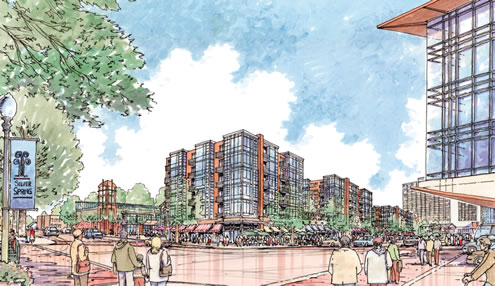IN THE PRESS
First Baptist Church of Silver Spring fails to earn historic designation
Developer can move forward with plans to build apartments, retail and new church
Article Published on Gazette.net - March 30, 2011 [view]
by Alison Bryant | Staff Writer

An apartment and retail mixed-use development in downtown Silver Spring can move forward as planned now that a church on the property has not been designated as an historic site.
The historic preservation commission of Montgomery County Park and Planning voted 6 to 2 March 23 to not designate the First Baptist Church of Silver Spring an historic site, which means the church is not required to be preserved during construction.
The commission decided the structure does not meet the designated criteria listed in the Historic Preservation Ordinance, said Clare Lise Kelly, research and designation coordinator for the historic preservation section. Criteria includes historic and cultural significance, and architectural and design significance.
"[The commission] didn't find that the church was noteworthy architecturally," Kelly said.
The Silver Spring Historical Society nominated the First Baptist Church for historic designation Nov. 24 in an attempt to save the church, in full or in part, from demolition as part of an upcoming development. LaKritz Adler Real Estate Investments, a Washington, D.C.-based development firm, plans to build mixed-use retail and apartments and rebuild the church on the site.
"The Silver Spring Historical Society was very disappointed that the HPC and the First Baptist Church of Silver Spring totally disregarded our compromise of partial preservation that would have preserved only the facades of these two historic structures," said Jerry A. McCoy, president of the Silver Spring Historical Society, in an email. "This was successfully done with the 1946 Canada Dry Bottling Plant, resulting in unique project that received national acclaim."
The church was built in 1956 and designed by local architect Ronald S. Senseman.
"In the discussion, [the commission] talked about how [the church] once had had an important setting," Kelly said. "And that that area has really changed a lot now and it didn't meet the criteria."
At one point, the four corners of the intersection of Fenton Street and Wayne Avenue was a civic node, featuring the Silver Spring Armory, Kelly said. But those corners no longer serve that purpose, she said.
"Preservation of the church facades would not have impinged on the First Baptist Church congregation's mission," McCoy said in an email. "Instead, like the historically designated 1927 Silver Spring Armory that stood across the intersection from the church, Silver Spring loses yet another piece of its heritage. The resulting design of the mixed-use project for the church site will further lead to the homogenization of downtown Silver Spring as Anywhere, USA."
Historic designation nominations go through a series of reviews, Kelly said. The Historic Preservation Commission recommendations are given to the Montgomery County Planning Board, she said. It is up to the planning board to decide whether to take up the issue.
The mixed-use development slated for the site will include between 200 and 220 apartments and approximately 30,000 square feet of retail space, Adler said. Torti Gallas and Partners, an architecture firm with offices in Silver Spring, will handle the design of the buildings.
The site includes a public pedestrian walkway and plaza. Buildings on the Fenton Street and Wayne Avenue corner will feature a more modern look, while those on Bonifant Street will look more traditional.
Josh Adler, managing partner of LaKritz Adler, said the decision came as a great relief to the developer and churchgoers in favor of building a new church.
"While I think that there was little doubt that, eventually, at some level in the process, the historic issue would be overcome, it's a big relief to have them over so early in the process," Adler said.
Duncan McIntosh, pastor of the church, cited multiple structural issues with the building that would be costly to repair. The only part of the church up to fire code is the preschool, he said. An 8,000-gallon underground tank of chilled water sprung a leak in 2007, creating a sinkhole on the property. The entire second floor of the 1931 building is sealed off.
"Historic preservation is an important cause and it's a very legitimate concern in communities," Adler said. "It's something we're in favor of, but [the historical society doesn't] help their cause when they try to obtain designation for buildings that shouldn't be designated."
The East Silver Spring Civic Association and Seven Oaks/Evanswood Citizens Association both voted in favor of a zoning text amendment that would allow the developer to build an extra floor on the Wayne Avenue side of the property, Adler said.
Zoning regulations now allow buildings up to 60 feet tall on the entire site. The developer would like to change this text to allow buildings up to 68 feet on the Wayne Avenue and Fenton Street portion of the property.
The developer is now in the process of working out the detailed language of the agreement with citizens association members, a process that will take about a month, Adler said.
abryant@gazette.net

